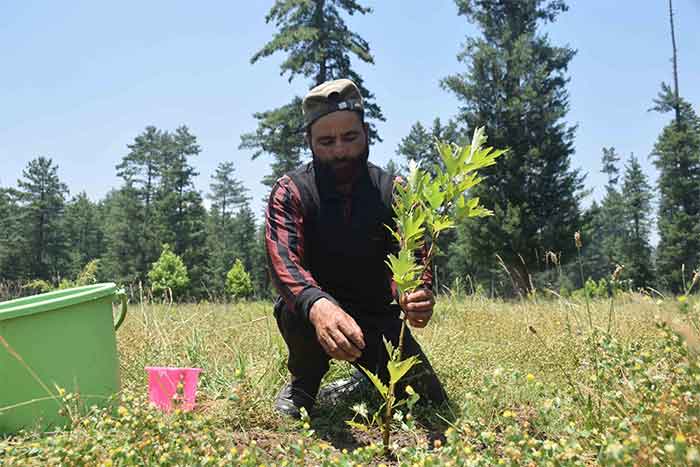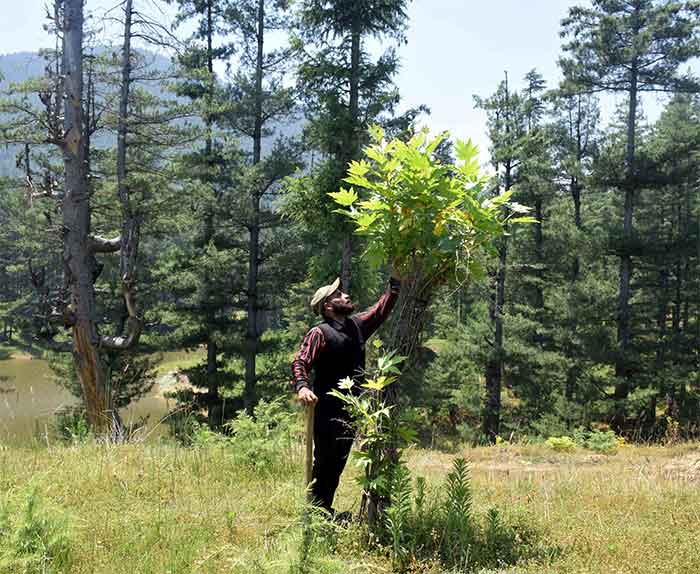
To exist as a nation, to prosper as a state, to live as a people, we must have trees.” – Theodore Roosevelt
In the times, when trees are being cut down in the name of development, production for firewood or just occupying land, Abdul Ahad Khan, a 38-year-old labourer from Nagri in Kupwara, for the past 15 years, has been tirelessly planting chinar trees, transforming empty spaces into lush forests. His unwavering dedication has earned him the title of the ‘Chinar Man’ of North Kashmir. He has single headedly planted hundreds of Chinar trees and nurtured them. He plants Chinars in the month of March every year. He planted 12 trees in the first year, but just four of them had grown. He soon learned that the Chinar tree needs water at the beginning, which he takes care of now.
He started on this mission of planting Chinar trees after seeing a dismal forest in his area. In Hatmulla alone, he has planted 250 Chinar trees, and hundreds more in various other areas of the district. In addition, he has also contributed around 700 Chinar branches to the Zangli forest department for cultivation in their nurseries, free of charge. He has played a significant role in the development of the Nargi-Wari Park.
His tireless efforts have not only created lush green spaces but have also contributed to the preservation of an important element of Kashmir’s natural heritage.
With the backing of the forest department and the recognition from the community, Khan hopes to continue his mission and safeguard the future of Chinar trees in the region.

The Chinar as Kashmir’s heritage
The Chinar is not just a tree. It is Kashmir in itself. It has been a witness to Kashmir’s history. It’s Kashmir’s very own speaking tree. As Sir David Attenborough says: “Ancient trees are precious. There is little else on Earth that plays host to such a rich community of life within a single living organism.”
It is Kashmir’s living heritage and is part of the culture. It is just a myth that the Mughals introduced this magnificent tree to Kashmir. It has been part of Kashmir’s antiquity. The word Chinar is attributed to Jahangir when, on seeing the Chinar’s fiery red autumn colour, he is said to have exclaimed, in Persian, “chi naar” (what a fire).
Locally known as buen/ boni kul, the centuries-old Kashmir Chinars are considered living testimony to region’s art, crafts, literature, leisure, politics and conflict as well. The tree grows over 20 meters in height, while its girth can go up to 50 feet.
Mughals, enamoured by the Chinar, planted it manifold, especially in the famous Mughal Gardens – Nishat Bagh and Shalimar Bagh. It is said that when the Jamia Masjid was gutted in a fire, during the time of Aurangzeb, the first thing he inquired about were the Chinars in the precinct of the mosque. He is believed to have said that even a hundred Aurangzeb’s cannot make one Chinar. This unfortunately
As Saleem Beg, convenor INTACH, J&K chapter pointed out, Chinar was mentioned by Lal Ded in her poetry, known as vokhs and couplets of Sheikh-ul-Alam, known as shruks.
The fifth-century Gilgit manuscripts – handed over to Pandit Nehru by Sheikh Abdullah during tribal raids in 1947, has Chinar imprints bordered on sides. This suggests that Chinar existed in Kashmir over 1500 years before the Mughals came to Kashmir.
The general presumption is that Chinar is a native of Greece, from where it spread to Europe, Central Asia and further eastward across the Hindukush range, into Afghanistan, NW Pakistan and Kashmir.
In Srinagar, the Chinar is found not just in the Mughal gardens but also in the Eidgah (Noefli buenee – where people offered the pre-dawn Nafl prayers), in Naseem Bagh of Kashmir University, Hazratbal, Lalit Hotel (which used to be Maharaja Hari Singh’s Palace) and Char Chinar, besides lining several avenues.
The Chinar in Kashmir has been a witness to several historical events – of gatherings, protests and rallies, of celebrations, of reverence, of death, of pain and joy, of discussions and debates. The word Chinar finds its way in to some common phrases as well – a heavy built person is ridiculed as buenee ghod (Chinar trunk) and a mother is often referred to as shehjar buen (shade of the Chinar).
Chinar has found a place in the work of every artist’s and every poet’s work on Kashmir. Allama Iqbal’s works clearly reflected his emotional attachment to Kashmir and its suppressed people. He writes about the Chinar in his Armaghan-e-Hijaz
Jis khaak ke zameer me hai aatish-e-chinar,
Mumkin nahi ki sard ho woh khaak-e-arjumand
(The earth that enshrines in its conscience the fire of the Chinar tree
Its exalted/celestial dust can never become cold.)
Other poets mesmerised by the tree include Mahmood Ghami, Mehjoor, Mirza Qalamudin Shaida , and Qazi Ghulam Mohammad (a mathematician who also wrote poetry). Ahmed Shaheen who died in 1947 on the other side of the LoC, longing for his motherland, wrote the poem Daag Teh Dagh (a taint and a pain).
Its green leaves of summer turn blood-red with the arrival of autumn and finally yellow marking the onset of winter. Agha Shahid Ali, reminisces the orange hue of the autumn Chinar leaves and laments: “I will die in autumn in Kashmir”
Sheikh Mohammad Abdullah, named his autobiography as Aatish-e-Chinar (Fire of Chinar).
Chinars of Kashmir
The Dal Lake has three islands, two of which are marked with beautiful Chinar trees located in Bod Dal and Lokut Dal and known as Rupa Lank (Silver Island) and Sona Lank (Gold Island). Rupa Lank, constructed by Murad Baksh, brother of Mughal emperor Aurangzeb, is marked with the presence of Chinar trees at the four corners, thus known as Char-Chinari (Four Chinars), reduced to two now. Sona Lank overlooks the holy shrine of Hazratbal.
Dalgate has a Chinar Bagh on the banks of Chuntikoul. Buen Zou at Sangam Shadipora is famous for its stunted Chinars, and became popular after the mortal remains of Indira Gandhi were immersed there in Jhelum.
The Chinar tree not only featured in poetry but has also been part of the local folklore. Many trees named after people who planted them or had some sort of association. Hasheh Noshi Henz Buen, at Ganderbal, is reminiscent of the legend that this Chinar was grown by a Pandit duo, a mother in law and a daughter-in-law. Gaffar Poulicen Buen at Naidyar Rainawari was planted by a policeman named, Gaffar. Ramzaan Mamein Buen at Awantipora was a key shade for pedestrians to rest till it was axed for expanding the highway.
Asaan Mamin Buen is at Khrew Shoor, and near Ramji Kak’s temple at Maharaj Gunj is Buene Yarbal (meeting place). Aweeraen Buen is in Batamaloo, Langar Buen has been at Waris Khan Bagh, since the days of Akbar, Nayeid Buen is where the Nayeid Mohalla once existed in the downtown area of Srinagar. The cluster of Chinar’s around Polo Ground, was once the main spot for testing the driving skills.
Yesteryears’ Bollywood movies also chose locations with Chinars. Films like Arzoo, Jab Jab Phool Khelei, Kashmir ki Kali, showed Kashmir’s scenic landscape especially of the Char Chinari in Dal Lake. The Char Chinari Island gardens came into limelight in 1970 with the movie song of Achha To Hum Chalte Hain of Aan Milo Sajna movie of 1970 filmed on Rajesh Khanna and Asha Parekh. While the new-era Bollywood movies such as Mission Kashmir, Lamha, Haider, Yahaan, Harud symbolised Chinar to show Kashmir’s conflict. One of Kashmir’s female folk singers of the 80s, was known as Bouni Begum and Boonyi, is one of the protagonists, a Kashmiri Pandit girl, in Salman Rushdie’s Shalimar The Clown.
To mark 75 years of Independence, the authorities announced the plan to build the largest Chinar Park ‘Chinar Zaar’ on the foothills of Srinagar’s Zabarwan mountain range. The Srinagar based 15-Corps has assumed the name of Chinar Corps.
Chinar is the only living fossil in Kashmir. What was believed to be the oldest Chinar tree, was planted some 700 years ago and is located at Chattergam Chaadoora in Budgam district. It has a girth of over 48 feet and a height of 62 feet. According to renowned environmentalist Muhammad Sultan Wadoo, the tree was planted by a Sufi saint, Syed Abul Qasim Shah Hamdani, in a garden at Chattergam in 1374 AD. Earlier, the largest and the oldest Chinar tree was considered to be at Bijbehara, the Chinar Town, in Anantnag district.
Botanists know the Chinar or Platanus orientalis, is a huge oxygen machine and its leaves are considered to have anti-inflammatory and antinociceptive properties. In Kashmir, an earlier practice used green Chinar leaves in packaging various items like mulberry, butter, mutton and cheese. This would help prevent contamination. Fallen and dried Chinar leaves have, however, remained a key ingredient of the charcoal for Kangris during winters.
Besides being a giver of shade and a mark of Kashmir’s beautiful landscape, for centuries, it has also found its place in spaces of faith, irrespective of religion. The magnificent tree at Chattergram shrine signifies the importance of the Chinar as a revered tree, even by preachers from Central Asia and Persia. Chinar can be found in shrines and temples (like the Kheer Bhawani temple in Ganderbal) across the Valley. The tree was equally venerated by the Kashmiri Pandits famous Kheer Bhawani temple in Ganderbal’s Tulmulla village.
When Emperor Akbar and prince Jahangir went for the waterfowl hunt in Chadoora, they were met with a heavy hailstorm. The royals, along with their entourage of 34 people and five horses, according to Abul Fazal’s Ain i Akbari took refuge under a mighty Chinar.
It is said that the Chinar, before it dies, develops a hollow truck. Traditionally, this hollow khoukhur was believed to be the abode of Djins. These hollows have also been home to many homeless wanderers and saints.
Baharistan-i -Shahi, a chronicle of Kashmir’s medieval history, has mentioned that in 1339 when Mughals finally ousted the local Sultans, the latter took a shelter in a Chinar.
The Chinar also deeply impacted the Kashmiri arts and crafts. The Chinar motif is found on shawls, on carpets and other embroidered and printed fabrics. It is on items crafted in walnut wood, copper and silver.
Several older trees have been found in central Kashmir, one of which appears to be nearly 1,000 years old, with a girth of over 50 feet, and is located in Budgam itself. In Ganderbal district also there are trees which have girth over 50 feet. The geo-tagging and census process revealed that Srinagar, Budgam, Ganderbal and Anantnag districts have more Chinar trees than the remaining districts.
Apathy prevails towards the Ecological Heritage
The number of Chinars in the Valley has, however, reduced over the decades, from an estimated 42,000 to below 20,000. This means that an approximate number of 25,000 of trees were lost 0ver a period of just over 30 years. According to Muhammad Sultan Wadoo, nearly 750 Chinar trees are lost every year.
Jan Haenraets, Professor of Practice at the Preservation Studies Program, Boston University and Adviser to the Indian National Trust for Art and Cultural Heritage, Jammu & Kashmir Chapter, writes: Knowing that it takes around 150 years for a Chinar to grow to its full size, we could use as an example 250 years, as the potential average age of these heritage trees. This number could well be higher. If we multiply 250 years times 25,000 Chinar trees, then it would mean that probably over 6,250,000 years of Chinar growth were already lost up to 2004… What makes this figure even more hallucinant is that all these losses and tree fellings occurred while ‘The Jammu and Kashmir Reservation of Specified Trees Act (1969)’ has been in place… Even worse is that many veteran Chinar trees are being lost rapidly at sites such as Nishat Bagh and Shalimar Bagh. This while these garden sites are going through a project to achieve UNESCO World Heritage Listing, and already were included on the UNESCO Tentative List… These issues illustrate how authorities lack a basic knowledge of heritage landscape conservation and management.
The first major axing spree was during the filling of Nallah Mar in the 1970s, when the canal was converted to a road, followed by the 90ft road from Soura to Nagbal on the outskirts of Srinage. The road widening from Pantha Chowk, on the outskirts of Srinagar to Sempora, in South Kashmir, resulted in cutting of several Chinar trees.
On my recent visit I saw the concretisation of the Shalimar canal, with supposedly “beautiful” bridges across. The trees of the Chinar Avenue along Shalimar Canal, a most significant part of the garden, are all but lost. Just a few Chinar trees survive in a sorry state. The rampant concretisation and lack of replanting of trees in Srinagar is an irreversible loss in terms of trees, water percolation and is already showing its results.
According to the Chinar Development Authority (CDA) estimates there are 4485 Chinars in Ganderbal, 5021 in Anantnag, 2330 in Pulwama, 2282 in Shopian, 1848 in Kulgam, and 1470 in Bandipora, and 2459 in Budgam. In Srinagar and Baramulla, the current numbers are at 6366 and 3961 respectively.
Over the years, some major Chinar gardens have vanished. One garden was in Srinagar city’s outskirts at Ellahi Bagh. Laid by Bashir Khan Rizvi, a Mughal governor, it now is left with barely a few Chinars. Rapid urbanisation has also contributed to the startling reduction of Chinars.
Zareef Ahmad Zareef, pained over ‘Kashmir’s heritage’ being vandalised set up the Bouine Bachao Committee, with Bansi Parmu when two majestic Chinars were axed at present-day Abdullah Bridge in 1984.These two Chinars had been planted by the English Resident (official agent) to Kashmir in 1880.
This movement marked the beginning of an initiative to preserve the ‘ecological heritage’ by the Floriculture Department, which formed the Chinar Development Authority (CDA) in 1986 . Chinar trees are being felled rapidly in Kashmir, despite a ban enacted in 2009 to curb cutting. Chinar trees are now required to be registered, considered State Property, and painted white at their base. However, this doesn’t seemed to have deterred further axing of Chinar trees, as done recently for development of roads and the Srinagar Smart City.
Before 1947, it was a tradition and the norm for the village sarpanch or the guardian, to plant a Chinar on street junctions. After it was planted, it would be entered in the revenue records. According to Zareef, besides urbanisation and expansion, people have also been responsible for reducing numbers of Chinars. Yengeh (Hing or asafoetida) is being applied to roots on a consistent basis to induce a slow death.
Increased construction and vehicular movement over the root zone has also led to weakening of roots of the Chinar trees in many places. Damage is also caused by pollution and slow disappearance of water streams and channels.
Haenraets adds: “a critical point has been reached to safeguard the Chinar heritage and the natural treasure it represents for the long-term future.”
A ‘Chinar Man’ is needed in every district, perhaps every city of Kashmir to preserve the scenic beauty of what has come to be known as the Paradise on Earth.
Jaspreet Kaur, architect & urban designer based in Delhi
Photos of Abdul Ahad Khan by Shah Jehangir














































